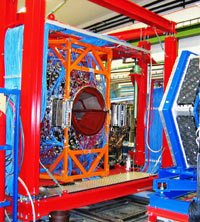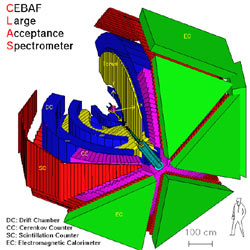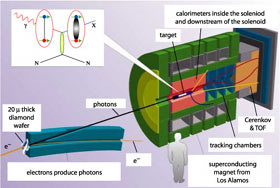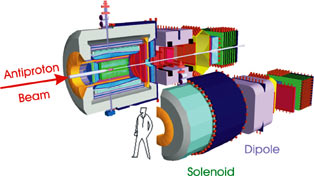The Edinburgh and Glasgow Nuclear Physics Groups have very strong ties. These have mainly developed through an internationally recognised collaboration on the use of electromagnetic probes of Nuclear Structure. This work developed 'Hadrons in Nuclear Physics', a field where exciting new developments were taking place, and for which major new international facilities have been constructed to significantly improve our understanding of nuclear and hadronic matter.
The SUPA initiative had two strands:
- Measurement of global nucleon properties and of the nucleon's excitation spectrum at the new MAMI C electron accelerator in Mainz, Germany and at CLAS in Jefferson Lab (JLab) in the US
- Search for exotic hadrons with GlueX at the upgraded 12 GeV CEBAF electron accelerator in JLab and with PANDA at the new 15 GeV antiproton storage ring HESR of the FAIR facility at the GSI site in Darmstadt, Germany.
 We continued our experimental campaign with the A2 Collaboration at MAMI C to perform double polarisation measurements of the Gerasimov-Drell-Hearn sum rule, which ties the integral of spin-dependent total photoabsorption cross sections over the excitation spectrum of the nucleon to its anomalous magnetic moment. We had a series of experiments on the structure of nucleon resonances with the determination of the magnetic moment of the
We continued our experimental campaign with the A2 Collaboration at MAMI C to perform double polarisation measurements of the Gerasimov-Drell-Hearn sum rule, which ties the integral of spin-dependent total photoabsorption cross sections over the excitation spectrum of the nucleon to its anomalous magnetic moment. We had a series of experiments on the structure of nucleon resonances with the determination of the magnetic moment of the![]() (1232) and S11(1535) nucleon excited states and investigate the mysterious nature of the Roper P11(1440) resonance using the upgraded Glasgow Tagger with the linearly polarised photon source and the new Crystal Ball plus TAPS setup (see left hand figure) in Mainz. The Edinburgh-Glasgow team played vital roles in the development of this equipment and are lead investigators in four major projects of the CrystalBall@MAMI Collaboration.
(1232) and S11(1535) nucleon excited states and investigate the mysterious nature of the Roper P11(1440) resonance using the upgraded Glasgow Tagger with the linearly polarised photon source and the new Crystal Ball plus TAPS setup (see left hand figure) in Mainz. The Edinburgh-Glasgow team played vital roles in the development of this equipment and are lead investigators in four major projects of the CrystalBall@MAMI Collaboration.
 At higher excitation energies, we are faced with the puzzling question why there are so many more resonances of the nucleonic three quark system predicted by the quark model than hitherto observed. We will study this problem by measuring the production of vector mesons (
At higher excitation energies, we are faced with the puzzling question why there are so many more resonances of the nucleonic three quark system predicted by the quark model than hitherto observed. We will study this problem by measuring the production of vector mesons (![]() ,
,![]() and
and ![]() ) and kaons on protons at the CLAS
) and kaons on protons at the CLAS ![]() detector at JLab. The CLAS linearly polarised photon beam, commissioned by members of our team, is used to bombard a frozen spin target. This enables searches for missing resonances using both single and double polarisation techniques. The linearly polarised beam also enabled our collaboration to determine the parity of the
detector at JLab. The CLAS linearly polarised photon beam, commissioned by members of our team, is used to bombard a frozen spin target. This enables searches for missing resonances using both single and double polarisation techniques. The linearly polarised beam also enabled our collaboration to determine the parity of the![]() particle - a very important measurement for constraining pentaquark models.
particle - a very important measurement for constraining pentaquark models.
 One of the prime objectives of the Jefferson Lab 12 GeV upgrade project was to study quark confinement, the most striking aspect of hadron structure. This is best performed by investigating exotic QCD configurations. Such studies provide new insights into the fundamental characteristics of the nuclear force through the exploration of the largely unknown dynamics of quark-gluon systems. The Jefferson Lab flagship facility is the Hall D / GlueX experimental station, which allows searches for light hybrid mesons with quark-gluon content
One of the prime objectives of the Jefferson Lab 12 GeV upgrade project was to study quark confinement, the most striking aspect of hadron structure. This is best performed by investigating exotic QCD configurations. Such studies provide new insights into the fundamental characteristics of the nuclear force through the exploration of the largely unknown dynamics of quark-gluon systems. The Jefferson Lab flagship facility is the Hall D / GlueX experimental station, which allows searches for light hybrid mesons with quark-gluon content![]() and thus the investigation of gluonic, chromoelectric excitations.
and thus the investigation of gluonic, chromoelectric excitations.
 Another type of exotic hadronic matter are glueballs, which are made of gluons only. Antiprotons are ideally suited for their production. The study of glueballs using antiprotons is one of the primary goals of the PANDA Collaboration at the international Facility for Antiproton and Ion Research, FAIR, at the GSI site in Darmstadt, Germany. In addition, PANDA enabled us to search for heavy, charmed
Another type of exotic hadronic matter are glueballs, which are made of gluons only. Antiprotons are ideally suited for their production. The study of glueballs using antiprotons is one of the primary goals of the PANDA Collaboration at the international Facility for Antiproton and Ion Research, FAIR, at the GSI site in Darmstadt, Germany. In addition, PANDA enabled us to search for heavy, charmed![]() hybrid mesons, a programme that is complementary to GlueX. Our team has been one of the founders of the PANDA Collaboration and has been heavily involved in the design and implementation of the experiment.
hybrid mesons, a programme that is complementary to GlueX. Our team has been one of the founders of the PANDA Collaboration and has been heavily involved in the design and implementation of the experiment.
